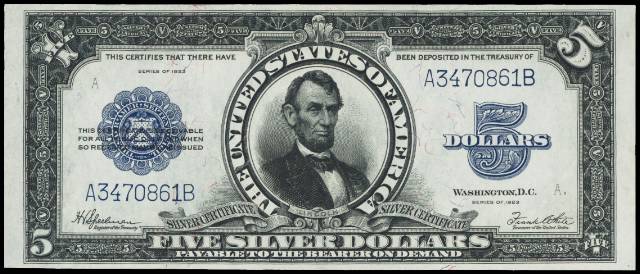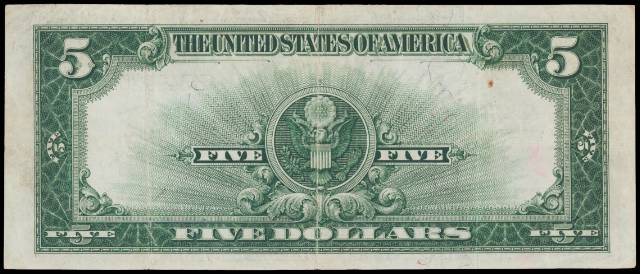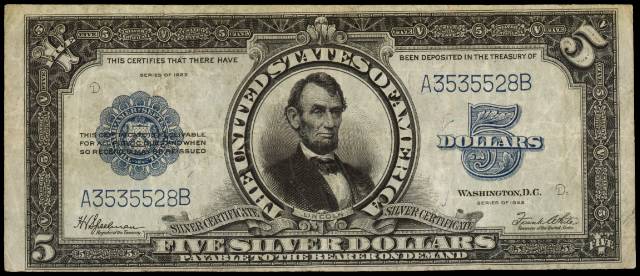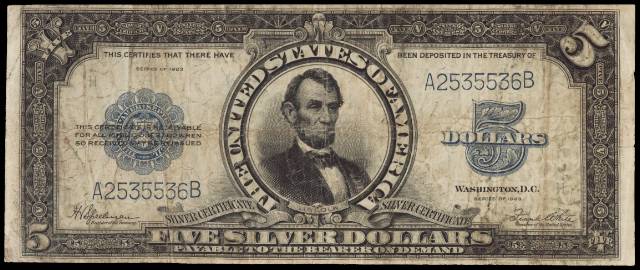Series of 1923 $5 Silver Certificate – Porthole
History: The 1923 $5 bill is an important bill in the history of United States money. It is what is known as a unique design type. Often times, especially in the 19th century, new money was just a partial redesign of older issues. The 1923 $5 bill looks somewhat similar to 1914 $5 Federal Reserve notes because they both feature blue seals and have Abraham Lincoln on them. However, 1923 five dollar notes are actually the only large size $5 silver certificate printed during the 20th century. That means that this note is on a lot of want lists. Lincoln specialists collect them, as do five dollar bill collectors, silver certificate collectors, and type design collectors. So despite the fact that over four million of these were printed, and well over 1,500 are known to exist, they still command good money in today’s market. We have price and value information further down the page.
Nickname: The 1923 $5 silver certificate has a great nickname. It is called a porthole by collectors. It appears that the portrait of Abraham Lincoln is being observed from behind or in front of a ship’s porthole. Lots of large size notes have great nicknames, but porthole is right up there near the top of the list. Do not confuse this nickname with 1899 $2 silver certificates which are called mini-portholes.
Other Facts: 1923 was the last year that large size money was issued, so 1923 $5 bills are the newest old five dollar bills that were printed by The United States. It is also the highest denomination silver certificate printed that year (one dollar silver certificates were also issued). All 1923 $5 bills are signed by Harley V Speelman and Frank White. Based on that signature combination we know that they could have been printed as late as 1927. All serial numbers begin with the letter A and end with the letter B.
Values and Grading: As with all large size silver certificates, the value of 1923 $5 bills is just going to be based on their condition, and maybe their serial number. If the serial number is under 100 then you can certainly expect more money than usual. If the serial number begins with a star symbol then the note will also command a premium. However, there are a couple dozen uncirculated star notes known to exist, which is the only reason 1923 $5 bill star notes are not super rarities.
Most 1923 $5 bills you encounter will be standard issue notes. The value of these notes is just based purely on their condition. We have included four different pictures so you can get a feel for the different grades. Any time you grade something you have to use the most critical eye possible because the person buying from you will be equally critical.
Choice Uncirculated or Better: 1923 $5 bills are actually relatively common in uncirculated conditions, but you will have to pay up if you want one. There are large price jumps between something graded as a 63 and something as high as 68. Both notes will have crisp white paper and no folds. However, the 63 will be centered poorly, meaning that there is more white margin on the top to bottom or side to side. The 68 will have even white margins all the way around.

We Pay $4,000 or More for 1923 $5 Bills in Perfect Condition
Extremely Fine to About Uncirculated: It is very difficult to show what makes a 1923 $5 bill XF or AU just based on a scanned image. You really have to have them under light and at angles to really make the condition issues pop. However, just generally speaking, an XF will usually have two or three folds. Portholes in AU condition will look perfect at first glance. However, closer examination will typically reveal a single fold, bend, or handling. A rule of thumb is that if you see something that you think is a fold, then it probably is. 1923 $5 silver certificates in this grade range sell for between $1,750 and $3,500.
Very Fine: 1923 $5 bills in very fine condition can vary widely in eye appeal. However, they usually trade in a pretty tight price range. The low end of very fine usually sells for around $800 if properly graded and authenticated by a third party. Nicer examples with just a few folds will bring closer to $1,500. We have two different VF portholes shown below to help you get a better feel for what is what.
The first example has been graded as a very fine 30. The back is pictured here. You can see three extremely hard folds. Folds should not normally be that obvious. This particular note has a rust spot and that hurts the value some.

This Particular 1923 $5 Bill Is Worth About $1,200
Blue overprints usually stay very vibrant despite circulation. So when grading a 1923 $5 bill you need to focus more on the color of the paper and the amount of wear in general. The paper on the example below looks fairly strong. However, the color is dark. That just means that this particular silver certificate spent some time in circulation trading hands and in wallets. It was graded as a 20.

We Buy 1923 $5 Silver Certificate In This Condition for about $800
Fine and Lower: 1923 $5 silver certificates in fine or lower condition are basically available at will. Problem free examples still sell for around $600. Anything with tears, rips, rust, stains, holes, missing pieces, etc will be discounted significantly. We would just advise against buying anything with problems when there are so many problem free examples available.

This Is Nice for the Fine Grade and Should Sell for about $600
Need an Appraisal or Offer? We understand that grading and valuing a 1923 $5 silver certificate is an art and not a science. If you want to sell or need an offer, just send us pictures of what you have. Once we have scans or digital photos we can make you a firm offer and work from there. Sales@AntiqueMoney.com


